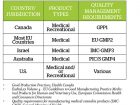
Features
Business
Human Resources
Management
Production
Practice makes perfect
"GMP” is the hot buzzword in the global cannabis industry right now as individual cannabis companies take note and begin the journey to implementation. However, blindly following the trend and implementing Good Manufacturing Practices (GMP) without strategic consideration and a sound business model may prove counterproductive.
May 28, 2019 By Karina Lahnakoski
 GMP” is the hot buzzword in the global cannabis industry right now
GMP” is the hot buzzword in the global cannabis industry right nowAs markets legalize, each jurisdiction is setting a stake in the ground and declaring their regulatory requirements for cannabis products, first seen with Canada and Good Production Practices (GPP), and now with the European Union and GMP. This impacts not only day-to-day operations, but strategic considerations, sustainability of businesses, and even the future of Canadian cannabis industry.
The regulatory choices being made are a result of a combination of available regulations, government objectives, and the types of products being legalized. As a result, there is little alignment in the industry, as is evident in Figure 1. For businesses planning to engage in trade, this misalignment of regulations creates additional hurdles for cannabis businesses.
Currently, the industry eagerly watches as markets in the EU open to cannabis legalization, which is the driver behind the desire for EU-GMP implementation. For businesses wanting to produce in, or export to the EU, implementation of EU-GMP makes perfect sense. Certainly, in Canada, this new potential market for products is receiving much attention and creating the GMP buzz. More than ever, cannabis firms need to have their strategy planned early on to include product type, market, and supply chain compliance and then the regulatory needs of their company.
Here are some tips for becoming GMP compliant:
Understand your product types.
GMP is not a requirement to sell medical cannabis, recreational products, or food grade cannabis raw materials in Canada. If you’re a food business, or selling to the edible markets, your focus should not be on EU-GMP, but GPP and Safe Food for Canadian Regulations (SFCS).
Understand the supply chain and market destination.
There are products that would require the implementation of GMP, but not EU-GMP. If you are supplying a drug manufacturer with cannabis product classified as API (active pharmaceutical ingredient) for a drug destined for the U.S., EU-GMP won’t achieve your goals. Your product, and how it is used in the supply chain is critical.
Know how GMP affects your operation.
The enormity of a GMP implementation program should not be underestimated and the timelines to attain it are not short. The EU-GMP standard is the same manufacturing standard that is applied to human drug products such as vaccines. It is very strict, and implementation programs are not straightforward. Implementation is multi-faceted, requiring knowledge from commercial horticultural (to meet Good Agricultural and Collection Practices, GACP) to medicinal Quality Management Systems (QMS) requirements.
The typical process for a GMP implementation program includes:
Confirming infrastructure meets the standard: The implementation of GMP requires the site to accept the infrastructure requirements of EU-GMP, which are quite prescriptive. If the facility is pre-existing, the ability of a site to address serious gaps in infrastructure requirements are limited from an engineering and cost perspective.
Define where in the operation GPP (if applicable) vs GACP vs GMP applies: The regulatory requirements will dictate the standards to be applied in different areas of the facility. This includes ensuring your facility is segregated appropriately, and that the flow of personnel, materials, equipment, and product is conducive to achieving a controlled facility. Existing facilities often find concerns in segregation and may require costly retrofit or engineering controls.
Quality Management System (QMS) updates: The implementation program hinges on performing a gap assessment between the existing QMS and the desired QMS. All systems in a facility will be impacted and must be fully implemented prior to being certified to GMP. An audit by a qualified cannabis GMP auditor is the best way to assess the gaps and determine when the updates are compliant.
Implementation of quality programs: Implementation of QMS programs can span from months to years and largely depend on having qualified resources focused on the implementation of GMP. Two major GMP programs that often take the most time are establishing a validation program (and supporting validation data) as well as establishing shelf-life data to support the expiration date of the products.
What the future holds
In the near term, there will not be an alignment of regulations between jurisdictions. The independent evolution of the Canadian system, the state-mandated systems within the U.S., and the requirement for EU-GMP in the EU countries mean that the international cannabis community will be left with regulatory barriers that impact business. Understanding your product, strategy, and the markets are key to successful business planning.
Karina Lahnakoski is vice-president of quality and regulatory affiliation at consulting firm Cannabis Compliance Inc. Email her at karina@cannabiscomplianceinc.com
Print this page

